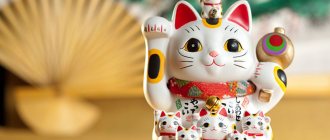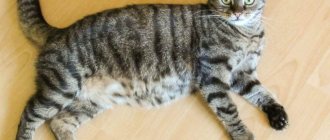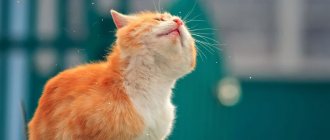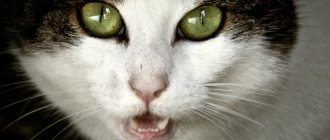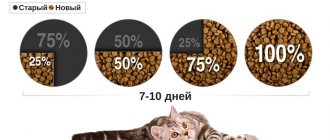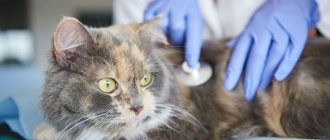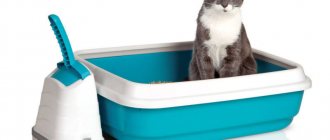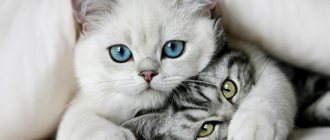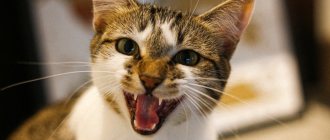Japan is a country where there are a sufficient number of felinological clubs and cat lovers clubs. However, at the moment, only one breed of Japanese breeders has been officially accepted by international organizations of felinologists.
In this country, with its unique traditions and culture, the national flavor leaves its mark on all areas of life, including the species diversity of cat breeds bred here. The unique approach and original requirements for the exterior have led to the fact that the selection of cats here is narrowly focused.
Legends of origin
The Japanese cat appears in several mythical stories. The legends of the Gotokuji, Imado, and Fushimi Inari temples are most often told. The first two are located in the current capital of the country, the third is in the former capital (Kyoto).
Priest cat
This story about the Japanese lucky cat Maneki-neko is the most famous. The legend dates back to Edo times and is associated with the temple complex at Setagaya. This temple was once loved by people, but then fell into disrepair. Ii Naotaka, who ruled the Hikone clan, passed by an abandoned sacred place after a hunt and saw a temple cat. The animal's paws beckoned the daimyo and his entourage to visit the house. This seemed strange to the ruler, so he went inside the temple. The daimyo was tired, the place seemed great for rest. Almost immediately a storm broke out, hurricane winds and incredible rain washed out the road. While inside, the daimyo realized that the cat had saved him from the weather. Imbued with gratitude, he donated the money spent on reconstruction to the temple, and the image of the pet itself turned into a happy sign.
Legends about the symbol are associated with the Edo period
The meaning of the Maneki-neko symbol has a second interpretation, also associated with the history of Naotaka. The daimyo was not far from the dilapidated temple when the storm began. He tried to hide under the trees, but suddenly saw a cat, as if inviting him with its paws. Naotaka approached the animal, at that moment lightning burned to the ground the tree under which he was hiding a minute ago. The daimyo realized that he had miraculously escaped death - he was saved by the temple cat. In gratitude for the good fortune, the ruler gave the holy place a generous donation, which made it possible to restore the structure and give it its current appearance.
Courtesan cat
Usugumo is a tayu whose history is preserved in Japanese myths. Her happiness lay in cats. Next to the woman there were always faithful companions - her pets. One day, in the dark, the courtesan was about to leave the house, but her beloved animal clung to her clothes, preventing the woman. A guard came to the sound and cut off the pet’s head, which flew to the ceiling and grabbed the snake that was threatening its owner with its teeth. With its last breath, the animal saved the woman and destroyed the dangerous reptile. The courtesan was sad about her lost pet and one day received as a gift from a guest a figurine depicting her favorite. She became her personal talisman. Soon others wanted one for themselves. So the figurine gradually spread throughout the country.
According to legend, the cat saved its owner from a snake
The story of the cat from Imado
This legend comes from the Edo period. In the west of the modern capital there lived an old woman, Imado. She led a miserable existence. All her life she had her beloved cat, but the old woman became so poor that she could not feed herself or her pet. She decided to drive the animal away so that it could survive on its own. Soon, her pet appeared to her in a dream, demanding that she make a figurine of a cat out of clay and place it at the door. The old woman obeyed. A little time passed and a passer-by, taking a closer look at the figurine, purchased it for himself. The woman realized that this could generate income and made several cats. Things went well and she became rich. Her pet returned home, the old woman lived with her for many more years in comfort and satiety.
Stories about a cat - stories of luck and success
Theory about the symbolic meaning of Maneki-neko
Mystics are sure that Maneki-neko is a deity who appears to people in the form of a cat beckoning with its paw. All legends show that higher powers favor people and help when no other help can be expected. If a cat invites, it is wise to follow him - this is a sign given by higher powers. It portends good things, foretells good luck.
Nowadays, rooms on the 3rd floor are often decorated with a figurine, since the number 3 in Japanese mythology is associated with good omens.
Reasons for the uniformity of selection
In Japan, representatives of the cat world enjoy such respect, honor and exclusive rights that they cannot count on in any other country in the world. This special attitude towards cats is caused by culture and religious and ritual traditions passed down over many centuries.
According to local beliefs, the tail of any animal is a concentration of devilish energy, negativity and destruction. This was the reason that cats with long tails were not particularly popular, while representatives with short tails became inhabitants of the imperial palace. The rest of the cats were destined for a terrible fate: their furry source of pride was simply chopped off by people who wanted to limit themselves from negativity.
It was here that kittens without this organ began to be born. It is possible that such mutations in cats occurred everywhere, but only Japanese residents reacted with enthusiasm to this fact and began to take especially careful care of tailless animals, which was the beginning of narrowly targeted selection.
The trait quickly took hold and became the main anatomical feature cultivated in Japan. Since the country remained closed for a long time, the new standards did not make any changes, and the breed became increasingly established and rooted during crossings between similar specimens. The species is called the Japanese Bobtail.
Why does Maneki-neko have a raised paw?
The paw of a talisman is the main identifying feature of a sacred thing. The product attracts good luck and calls for success, brings home financial comfort and money. Often the cat’s body is decorated with hieroglyphic inscriptions. They believe that the left paw attracts customers, so this talisman is suitable for public institutions. Some people prefer cats with two paws raised. They symbolize positivity. It is believed that the legendary cats used this gesture to call the daimyo to save them from storms and lightning.
The talisman's paw is a symbol of good luck
Varieties of mascot
The main differences between the forms are which paw is raised (right, left, both). A friendly cat may raise its paw to invite good luck. Different versions of the cat are popular in different regions of Japan. The symbolism spread beyond the country's borders and at the same time acquired other features - Thai and Chinese alluring cats are different from traditional ones.
Maneki-neko are different
Any raised paw is a source of good luck and success, prosperity and wealth. Maneki-neko is especially useful for entrepreneurs. The left paw is more helpful in business related to the night (bars, restaurants). The right one is more useful for a place that is open during the day. Souvenirs have been used in the home environment relatively recently.
Some believe that the right paw calls for luck and finances, while the left paw calls for clients.
Both raised paws are a symbol of protecting your home and business.
Terms of use
A cat waving its right paw is needed for home, and its left paw is needed for work. Together they complement each other.
Money cat location
Most often, the figures are placed at the entrance to a house or shop. Different directions of the world enhance the characteristics of maneki-neko:
- location on the northeast side will attract wealth;
- a cat in the southeast corner, where the “knowledge zone” is located, will help you invest more wisely.
If the figurine is in the office, then it can be placed on the desktop. To enhance the effect, it is placed in a money pot, where coins should be poured. If the cat can move its paw, running on simple batteries or solar energy, you need to make sure that it does not stop.
Color meaning
Classic – 3-color cat. These are more often found as pets, which is why the figures are usually painted in 3 shades. Canonical is not the only design option for a mascot. Many people like white, black, red, pink specimens. There are options in a heavenly shade and painted to match the color of grass and gold.
The shade is associated with the energy of the talisman. Black ones bring happiness to the owner’s life, protect against troubles, red ones counteract diseases and improve health. Previously, the Japanese believed that red was a cure for measles and smallpox. Such souvenirs are given to the sick or people who are afraid of getting sick.
Pink figurines are associated with good luck in your personal life. They attract tender feelings and promote partner fidelity.
Green souvenirs are considered symbols of security. They are popular with drivers and protect against problems on the road. The same ones help to study, therefore they are used by students and applicants.
The color of Maneki-neko has a special meaning
The following interpretation of colors is known:
- white – happiness, spiritual growth, purity;
- black – protection;
- red – general luck in all areas of life;
- golden - prosperity;
- red – protection from illness, determination, restoration of internal resources;
- pink – romance;
- yellow – happy marriage;
- blue – vitality, favorable relationships;
- green – mastering new things, good memory, creativity.
Tips and tricks for making your own maneki-neko
It’s not at all difficult to make such a cat with your own hands. Traditional figurines are made of clay, but at home you can make them from other popular materials:
- salt dough;
- papier mache;
- polymer clay.
Maneki-neko can be made from polymer clay.
You can also buy a wooden blank and paint it using the technique that the artist likes.
Some people put a note inside the figurine wishing them good luck. Although this solution is unconventional, it will help diversify the process and put soul into the product.
Value of additional items
The figurines complement:
- coins to attract money;
- a money hammer that attracts wealth;
- fish (carp), meaning good luck and long life;
- pumpkin, piece of metal, radish, sacred board (symbols of good luck);
- marble, crystal, pearl ball (money magnet and symbol of wisdom).
Medallions and bells are used as additional details. They turn the figurine into a protective talisman that attracts abundance and money to the house. It shows reverence, respect for a sacred pet, symbolizes caring for a beloved animal. The golden bell symbolizes spiritual and material values. This one is more popular not in its homeland, but in China, where gold signifies the determination to work tirelessly to gain wealth.
The figurine can be supplemented with a Koban worth 1 re. Such coins have been used before, the denomination is quite large. A cat with a coin in D is an image from the legend about an animal that stole a couple of coins for a sick merchant who was feeding the animal.
Souvenirs with bibs and bells are popular. Their appearance is connected with Japanese history. Previously, only wealthy people kept the animal at home, so an identification symbol was always hung on its neck. Everyone he met knew whose cat it was.
Additional elements give the symbol a special meaning
Often figurines are decorated with hieroglyphs denoting luck and success. They are written on the figurine’s belly.
If a cat holds a fan, it helps to cope with the most difficult tasks quickly and easily. The paddle symbolizes success in everything, and the blooming decorative cherry symbolizes endless love. For Maneki-neko, fruits mean prosperity and offspring, goldfish mean an abundance of money. If a cat is supplemented with a daruma, it will help realize a cherished desire, and an animal with uchide-nokozushi is associated with miracles.
Maintenance and care
Japanese Bobtails have virtually no undercoat. For the breeder, this feature is one big plus: there is a minimum of hair on the carpets during the molting period, which cannot be said about the cats themselves. Deprived of a protective downy layer that insulates the body from environmental influences, the “Japanese” are very sensitive to any drop in temperature and drafts. For this reason, find a truly warm and protected place for the cat basket. But without fanaticism: a bed next to a heating radiator is a serious overkill.
Hygiene
As for caring for Japanese bobtails, it all depends on which type of breed you own. If you have a short-haired bobtail in your home, you can relax, because a representative of this family will need to comb its “coat” no more than once a week. Long-haired “Japanese” dogs will have to pay more attention, because they need to be combed over their muscular bodies every day. In addition, shedding in long-haired cats is always more pronounced and mainly in the spring.
Japanese bobtails are bathed only in situations where they really cannot do without washing. These “Asians” are not afraid of water, but they will have to tinker with the process, if only because the breed’s wool has a strong water-repellent effect. Accordingly, trying to wet a cat’s “fur coat” will take much more time than the actual washing process. Cleaning the ears of a Japanese Bobtail follows the classic scenario: once a week, look into the cat’s ear canal. If it is dirty and smelly, go over the inside of the ear with a cloth soaked in alcohol-free veterinary lotion.
In especially severe cases, ear drops for cats will help, softening dried wax and dirt. Just don’t go to extremes by trying to penetrate into the very depths of the passage - you risk damaging your hearing. Trimming the Japanese Bobtail's nails is an optional event. If the pet is accustomed to the scratching post and uses it regularly, this is enough. But rubbing your cat’s eyes in the morning with herbal lotions or herbal infusions should become a tradition.
Feeding
Japanese bobtails are not entitled to any special “Asian” menu. Short-tailed purrs eat everything that other breeds do, that is, lean meat, boiled sea fish fillets and liver, which are recommended to be “enhanced” with viscous porridge based on rolled oats and buckwheat. However, like true Japanese, bobtails often prefer seafood over cold cuts. Once a week, the cat’s diet must be additionally “vitaminized” with chicken yolk, quail egg, fresh herbs or wheat sprouts. Low-fat fermented milk products are also beneficial for the breed, as are fruit and vegetable shavings.
The simplest and easiest way to feed a Japanese Bobtail is to switch it to industrial drying. However, most kittens from nurseries are already “sitting” tightly on it by the time they move to a new home. Therefore, the only thing that is required from the new owner in such a situation is to promptly fill the plate with dry croquettes and add fresh water to the bowl.
